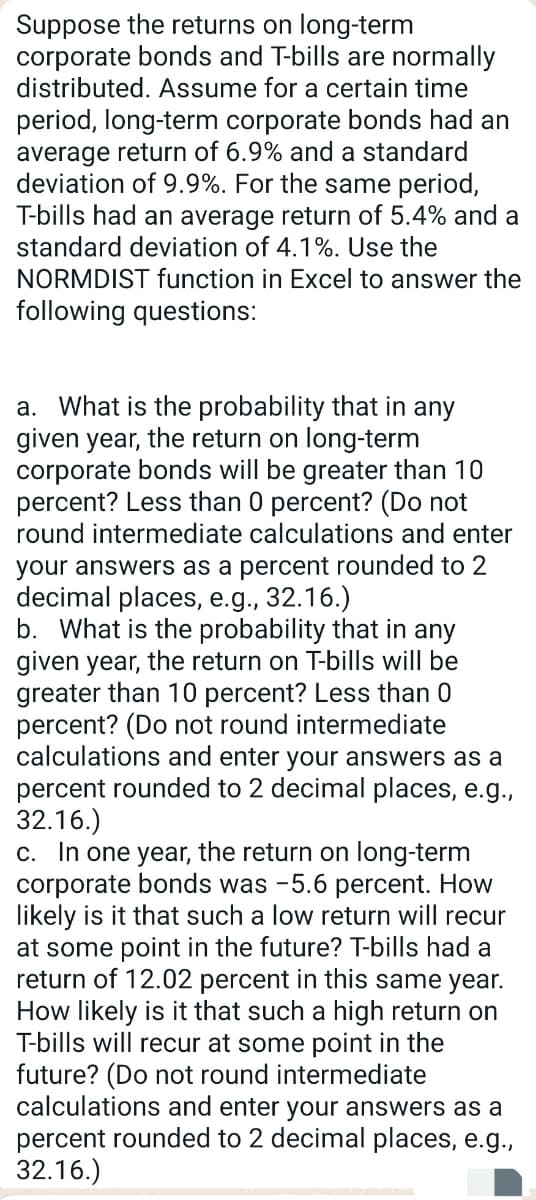Suppose the returns on long-term corporate bonds and T-bills are normally distributed. Assume for a certain time period, long-term corporate bonds had an average return of 6.9% and a standard deviation of 9.9%. For the same period, T-bills had an average return of 5.4% and a standard deviation of 4.1%. Use the NORMDIST function in Excel to answer the following questions: a. What is the probability that in any given year, the return on long-term corporate bonds will be greater than 10 percent? Less than 0 percent? (Do not round intermediate calculations and enter your answers as a percent rounded to 2 decimal places, e.g., 32.16.) b. What is the probability that in any given year, the return on T-bills will be greater than 10 percent? Less than 0 percent? (Do not round intermediate calculations and enter your answers as a percent rounded to 2 decimal places, e.g., 32.16.) c. In one year, the return on long-term corporate bonds was -5.6 percent. How likely is it that such a low return will recur at some point in the future? T-bills had a return of 12.02 percent in this same year. How likely is it that such a high return on T-bills will recur at some point in the future? (Do not round intermediate calculations and enter your answers as a percent rounded to 2 decimal places, e.g., 32.16.)
Suppose the returns on long-term corporate bonds and T-bills are normally distributed. Assume for a certain time period, long-term corporate bonds had an average return of 6.9% and a standard deviation of 9.9%. For the same period, T-bills had an average return of 5.4% and a standard deviation of 4.1%. Use the NORMDIST function in Excel to answer the following questions: a. What is the probability that in any given year, the return on long-term corporate bonds will be greater than 10 percent? Less than 0 percent? (Do not round intermediate calculations and enter your answers as a percent rounded to 2 decimal places, e.g., 32.16.) b. What is the probability that in any given year, the return on T-bills will be greater than 10 percent? Less than 0 percent? (Do not round intermediate calculations and enter your answers as a percent rounded to 2 decimal places, e.g., 32.16.) c. In one year, the return on long-term corporate bonds was -5.6 percent. How likely is it that such a low return will recur at some point in the future? T-bills had a return of 12.02 percent in this same year. How likely is it that such a high return on T-bills will recur at some point in the future? (Do not round intermediate calculations and enter your answers as a percent rounded to 2 decimal places, e.g., 32.16.)
Glencoe Algebra 1, Student Edition, 9780079039897, 0079039898, 2018
18th Edition
ISBN:9780079039897
Author:Carter
Publisher:Carter
Chapter10: Statistics
Section10.6: Summarizing Categorical Data
Problem 31PPS
Related questions
Question
Pls correct step by step explanation

Transcribed Image Text:Suppose the returns on long-term
corporate bonds and T-bills are normally
distributed. Assume for a certain time
period, long-term corporate bonds had an
average return of 6.9% and a standard
deviation of 9.9%. For the same period,
T-bills had an average return of 5.4% and a
standard deviation of 4.1%. Use the
NORMDIST function in Excel to answer the
following questions:
a. What is the probability that in any
given year, the return on long-term
corporate bonds will be greater than 10
percent? Less than 0 percent? (Do not
round intermediate calculations and enter
your answers as a percent rounded to 2
decimal places, e.g., 32.16.)
b. What is the probability that in any
given year, the return on T-bills will be
greater than 10 percent? Less than 0
percent? (Do not round intermediate
calculations and enter your answers as a
percent rounded to 2 decimal places, e.g.,
32.16.)
c. In one year, the return on long-term
corporate bonds was -5.6 percent. How
likely is it that such a low return will recur
at some point in the future? T-bills had a
return of 12.02 percent in this same year.
How likely is it that such a high return on
T-bills will recur at some point in the
future? (Do not round intermediate
calculations and enter your answers as a
percent rounded to 2 decimal places, e.g.,
32.16.)
Expert Solution
This question has been solved!
Explore an expertly crafted, step-by-step solution for a thorough understanding of key concepts.
This is a popular solution!
Step 1: Describe the given information
VIEWStep 2: Calculate the probability that the return on long-term corporate bonds will be > 10% and < 0%
VIEWStep 3: Calculate the probability that the return on T-bills will be > 10% and < 0%
VIEWStep 4: The likelihood that such low returns will recur at some point in the future for given scenarios
VIEWSolution
VIEWTrending now
This is a popular solution!
Step by step
Solved in 5 steps with 49 images

Recommended textbooks for you

Glencoe Algebra 1, Student Edition, 9780079039897…
Algebra
ISBN:
9780079039897
Author:
Carter
Publisher:
McGraw Hill

Glencoe Algebra 1, Student Edition, 9780079039897…
Algebra
ISBN:
9780079039897
Author:
Carter
Publisher:
McGraw Hill